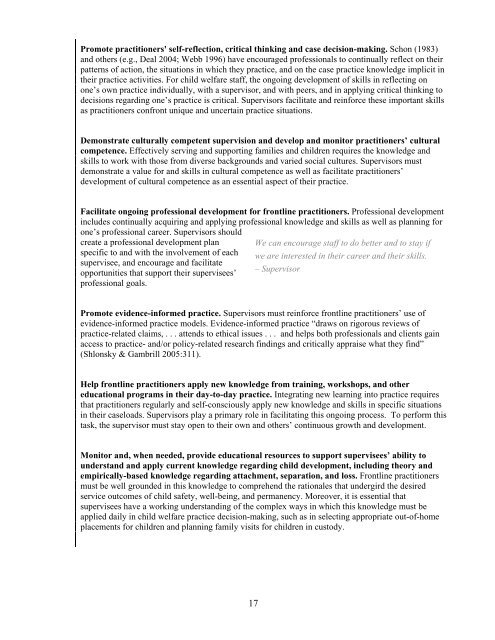Building a Model and Framework for Child Welfare Supervision
Building a Model and Framework for Child Welfare Supervision
Building a Model and Framework for Child Welfare Supervision
- No tags were found...
You also want an ePaper? Increase the reach of your titles
YUMPU automatically turns print PDFs into web optimized ePapers that Google loves.
Promote practitioners' self-reflection, critical thinking <strong>and</strong> case decision-making. Schon (1983)<strong>and</strong> others (e.g., Deal 2004; Webb 1996) have encouraged professionals to continually reflect on theirpatterns of action, the situations in which they practice, <strong>and</strong> on the case practice knowledge implicit intheir practice activities. For child welfare staff, the ongoing development of skills in reflecting onone’s own practice individually, with a supervisor, <strong>and</strong> with peers, <strong>and</strong> in applying critical thinking todecisions regarding one’s practice is critical. Supervisors facilitate <strong>and</strong> rein<strong>for</strong>ce these important skillsas practitioners confront unique <strong>and</strong> uncertain practice situations.Demonstrate culturally competent supervision <strong>and</strong> develop <strong>and</strong> monitor practitioners’ culturalcompetence. Effectively serving <strong>and</strong> supporting families <strong>and</strong> children requires the knowledge <strong>and</strong>skills to work with those from diverse backgrounds <strong>and</strong> varied social cultures. Supervisors mustdemonstrate a value <strong>for</strong> <strong>and</strong> skills in cultural competence as well as facilitate practitioners’development of cultural competence as an essential aspect of their practice.Facilitate ongoing professional development <strong>for</strong> frontline practitioners. Professional developmentincludes continually acquiring <strong>and</strong> applying professional knowledge <strong>and</strong> skills as well as planning <strong>for</strong>one’s professional career. Supervisors shouldcreate a professional development plan We can encourage staff to do better <strong>and</strong> to stay ifspecific to <strong>and</strong> with the involvement of each we are interested in their career <strong>and</strong> their skills.supervisee, <strong>and</strong> encourage <strong>and</strong> facilitateopportunities that support their supervisees’– Supervisorprofessional goals.Promote evidence-in<strong>for</strong>med practice. Supervisors must rein<strong>for</strong>ce frontline practitioners’ use ofevidence-in<strong>for</strong>med practice models. Evidence-in<strong>for</strong>med practice “draws on rigorous reviews ofpractice-related claims, . . . attends to ethical issues . . . <strong>and</strong> helps both professionals <strong>and</strong> clients gainaccess to practice- <strong>and</strong>/or policy-related research findings <strong>and</strong> critically appraise what they find”(Shlonsky & Gambrill 2005:311).Help frontline practitioners apply new knowledge from training, workshops, <strong>and</strong> othereducational programs in their day-to-day practice. Integrating new learning into practice requiresthat practitioners regularly <strong>and</strong> self-consciously apply new knowledge <strong>and</strong> skills in specific situationsin their caseloads. Supervisors play a primary role in facilitating this ongoing process. To per<strong>for</strong>m thistask, the supervisor must stay open to their own <strong>and</strong> others’ continuous growth <strong>and</strong> development.Monitor <strong>and</strong>, when needed, provide educational resources to support supervisees’ ability tounderst<strong>and</strong> <strong>and</strong> apply current knowledge regarding child development, including theory <strong>and</strong>empirically-based knowledge regarding attachment, separation, <strong>and</strong> loss. Frontline practitionersmust be well grounded in this knowledge to comprehend the rationales that undergird the desiredservice outcomes of child safety, well-being, <strong>and</strong> permanency. Moreover, it is essential thatsupervisees have a working underst<strong>and</strong>ing of the complex ways in which this knowledge must beapplied daily in child welfare practice decision-making, such as in selecting appropriate out-of-homeplacements <strong>for</strong> children <strong>and</strong> planning family visits <strong>for</strong> children in custody.17
















